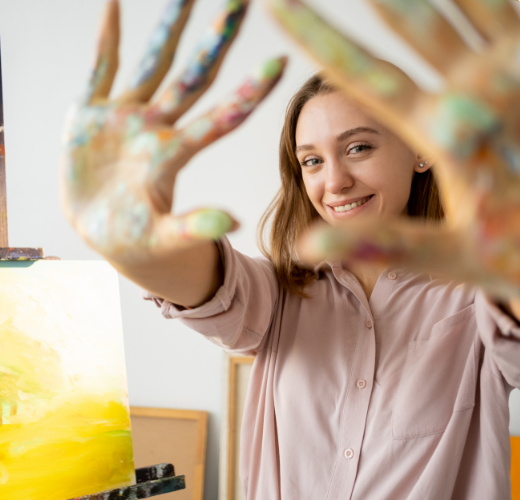Art Therapy for Healing Trauma: How Creativity Builds Confidence
Art therapy for healing trauma provides a creative way to process emotions and rebuild confidence. Through artistic expression, individuals can explore difficult experiences, gain insight, and develop healthier coping strategies. This approach makes healing more accessible for people of all ages, offering a non-verbal path to self-discovery and emotional balance.

How Art Therapy Supports Trauma Recovery
Experiencing trauma can make it difficult to express emotions, which is why art therapy for healing trauma is such a valuable tool. Many people struggle with expressing what they have been through, either because it feels too overwhelming or because they lack the words to describe it. Art therapy allows individuals to externalize these feelings in a way that feels safe and nonjudgmental.
A study published in Frontiers in Psychology highlights how art therapy helps regulate emotions by engaging the brain’s right hemisphere, which is responsible for processing images and emotions. This can be especially beneficial for those who have difficulty verbalizing traumatic experiences. Through drawing, painting, sculpting, or collage, individuals can explore emotions that might otherwise remain locked inside.
Building Confidence Through Creativity
One of the most profound benefits of art therapy is its ability to help people regain a sense of control. Trauma often makes individuals feel powerless. Creating something tangible, whether a painting or a piece of pottery, provides a reminder of personal agency. Each artistic choice—a color, a brushstroke, a shape—reinforces the idea that they have control over their own expression.
Art therapy also builds confidence by shifting the focus away from the trauma itself and onto personal strengths. Unlike traditional therapy, where discussing difficult experiences can sometimes feel overwhelming, art therapy encourages a forward-thinking mindset. Instead of defining oneself by past pain, creativity allows people to see themselves as capable, expressive, and resilient.
Practical Ways to Incorporate Art Therapy into Everyday Life

Art therapy is not limited to formal sessions with a therapist. It can be integrated into daily life as a self-care tool. Here are some practical ways to use art therapy techniques at home:
- Visual Journaling – Instead of writing about feelings, try drawing them. Use colors and shapes to reflect emotions without worrying about technical skill.
- Collage Making – Cut out images from magazines that resonate with personal experiences or aspirations. Assembling them into a visual story can help process emotions and inspire new perspectives.
- Clay or Sculpting Activities – Working with hands to mold and shape materials can have a calming, grounding effect, especially during moments of anxiety.
- Music and Movement Art – Expressing emotions through movement-based art, such as painting to music or using dance-inspired brushstrokes, can provide a release for tension and unspoken feelings.
Why This Matters for Everyone, Not Just Teens
While art therapy is often used with adolescents, it is beneficial for people of all ages. Trauma does not discriminate by age, and neither does creativity. Whether someone is recovering from a major life event or simply seeking an outlet for stress, engaging in artistic expression can be a powerful tool for emotional well-being.
Adults can use art therapy to process past experiences that still affect daily life. Parents may find it helpful as a bonding activity with children, encouraging emotional expression in a non-verbal way. Those in high-stress careers can turn to creative practices for relaxation and self-awareness.

How Eva Carlston Academy Uses Art Therapy
Art therapy at Eva Carlston Academy is an essential part of the therapeutic process. Students engage in various creative activities, guided by our trained professionals who understand the connection between artistic expression and emotional healing. Whether through painting, sculpture, mixed media, or many other art techniques we utilize, these experiences help young women explore their emotions in a supportive and encouraging environment.
Creativity allows our students to connect with themselves in new ways, and for many, it becomes a lifelong tool for managing emotions and building resilience.
Final Thoughts
Creative expression is at the heart of Eva Carlston Academy, where art therapy helps teens turn emotions into something tangible and meaningful. Whether processing past experiences or exploring personal identity, artistic expression offers a sense of control and clarity. Through structured therapy or personal creative practice, art becomes a powerful tool for healing, growth, and self-discovery.
Sources:
- Haeyen, S., van Hooren, S., van der Veld, W. M., & Hutschemaekers, G. (2021). “Promoting emotion regulation using art therapy: A randomized controlled trial.” Frontiers in Psychology. https://www.frontiersin.org/journals/behavioral-neuroscience/articles/10.3389/fnbeh.2024.1422361/full
- Malchiodi, C. A. (2020). Trauma and Expressive Arts Therapy: Brain, Body, and Imagination in the Healing Process. Guilford Press. https://psycnet.apa.org/record/2020-15662-000
Call: 801-449-0089
Address: 4943 S Wasatch Boulevard, Salt Lake City, Utah 84124
